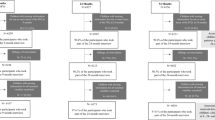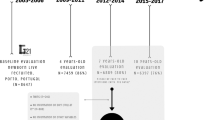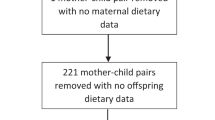Abstract
Objective: New findings, that relate poor foetal growth to long-term outcomes, highlight the need to understand more about the nature of women's diets before and during pregnancy. This study examines the influence of sociodemographic and anthropometric factors on the quality of the diets of young women in the UK.
Design: Diet was assessed by an interviewer-administered food frequency questionnaire. A single diet score was calculated for each woman using the first component defined by principal components analysis.
Setting: Southampton, UK.
Subjects: A total of 6125 non pregnant women aged 20–34 y.
Results: The diets of women with low diet scores were characterised by low intakes of fruit and vegetables, wholemeal bread, rice and pasta, yogurt, and breakfast cereals, but high intakes of chips and roast potatoes, sugar, white bread, red, and processed meat and full-fat dairy products. Educational attainment was the most important factor related to the diet score. In all, 55% (95% CI 50–59%) of women with no educational qualifications had scores in the lowest quarter of the distribution, compared with only 3% (95% CI 2–4%) of those who had a degree. Smoking, watching television, lack of strenuous exercise, and living with children were also associated with lower diet scores. After taking these factors into account, no other factor including social class, the deprivation score of the neighbourhood, or receipt of benefits added more than 1% to the variance in the diet score.
Conclusions: Poor achievement at school defines a substantial group of women in the UK who may be vulnerable. Many of these women have poor diets that are not simply a result of the level of deprivation in their neighbourhood, or of living at a level of poverty that entitles them to benefits. We suggest that it is a priority to identify and to address the barriers that prevent these women from improving the quality of their diets.
Sponsorship: The study was funded by the Dunhill Medical Trust, the University of Southampton and the Medical Research Council.
This is a preview of subscription content, access via your institution
Access options
Subscribe to this journal
Receive 12 print issues and online access
$259.00 per year
only $21.58 per issue
Buy this article
- Purchase on Springer Link
- Instant access to full article PDF
Prices may be subject to local taxes which are calculated during checkout

Similar content being viewed by others
References
Barker DJP (1995): Foetal origins of coronary heart disease. BMJ 311, 171–174.
Byers T (2001): Food frequency dietary assessment: how bad is good enough? Am. J. Epidemiol. 154, 1087–1088.
Coulston AM (2001): The search continues for a tool to evaluate dietary quality. Am. J. Clin. Nutr. 74, 417–418.
Department of Health (1994): Nutritional aspects of cardiovascular disease. Report of the Cardiovascular Review Group, Committee on Medical Aspects of Food Policy. London: HMSO.
Department of Health (1998): Nutritional aspects of the development of cancer. Report of the Working Group on Diet and Cancer of the Committee on Medical Aspects of Food and Nutrition Policy. London: The Stationery Office.
Fung TT, Rimm EB, Spiegelman D, Rifai N, Tofler GH, Willett WC & Hu FB (2001): Association between dietary patterns and plasma biomarkers of obesity and cardiovascular disease risk. Am. J. Clin. Nutr. 73, 61–67.
Groth MV, Fagt S & Brøndsted L (2001): Social determinants of dietary habits in Denmark. Eur. J. Clin. Nutr. 55, 959–966.
Hales CN, Barker DJ, Clark PM, Cox LJ, Fall C, Osmond C & Winter PD (1991): Foetal and infant growth and impaired glucose tolerance at age 64. BMJ 303, 1019–1022.
Harding JE (2001): The nutritional basis of the foetal origins of adult disease. Int. J. Epidemiol. 30, 15–23.
Hu FB, Rimm EB, Smith-Warner SA, Feskanich D, Stampfer MJ, Ascherio A, Sampson L & Willett WC (1999): Reproducibility and validity of dietary patterns assessed with a food frequency questionnaire. Am. J. Clin. Nutr. 69, 243–249.
Hu FB, Rimm EB, Stampfer MJ, Ascherio A, Spiegelman D & Willett WC (2000): Prospective study of major dietary patterns and risk of coronary heart disease in men. Am. J. Clin. Nutr. 72, 912–921.
Inskip H (1999): The Southampton Women's Survey. MIDIRS Midwifery Digest 9, 445–447.
Jackson AA & Robinson SM (2001): Dietary guidelines for pregnancy: a review of current evidence. Publ. Health Nutr. 4, 625–630.
Joliffe IT & Morgan BJT (1992): Principal component analysis and exploratory factor analysis. Stat. Methods Medods. Res. 1, 69–95.
Kearney JM & McElhone S (1999): Perceived barriers in trying to eat healthier - results of a pan-EU consumer attitudinal survey. Br. J. Nutr. 81, S133–S137.
Office of Population Censuses Surveys (1990): Standard Occupational Classification. London: HMSO.
Osler M, Helms Andreasen A, Heitmann B, Høidrup S, Gerdes U, Mørch Jørgensen L & Schroll M (2002): Food intake patterns and risk of coronary heart disease: a prospective cohort study examining the use of traditional scoring techniques. Eur. J. Clin. Nutr. 56, 568–574.
Robinson S, Godfrey K, Osmond C, Cox V & Barker D (1996): Evaluation of a food frequency questionnaire used to assess nutrient intakes in pregnant women. Eur. J. Clin. Nutr. 50, 302–308.
Slattery ML, Boucher KM, Caan BJ, Potter JD & Ma K-N (1998): Eating patterns and risk of colon cancer. Am. J. Epidemiol. 148, 4–16.
Townsend P, Phillimore P & Beattie A (1988): Health and Deprivation: Inequality and the North. Beckenham: Croom Helm.
Acknowledgements
We are very grateful to all the General Practitioners in Southampton who made this study possible, to the Southampton Women's Survey staff, and particularly to the women of Southampton for taking part.
Author information
Authors and Affiliations
Contributions
Guarantor: SM Robinson.
Contributors: SMR and SEB designed the food frequency questionnaire, SEB and JH were responsible for data collection, SRC was responsible for the statistical analysis, and HMI coordinated all aspects of the survey. DJPB was responsible for the establishment and the design of the Southampton Women's Survey. All authors contributed to the analysis and interpretation of the data, and the preparation of the manuscript.
Corresponding author
Rights and permissions
About this article
Cite this article
Robinson, S., Crozier, S., Borland, S. et al. Impact of educational attainment on the quality of young women's diets. Eur J Clin Nutr 58, 1174–1180 (2004). https://doi.org/10.1038/sj.ejcn.1601946
Received:
Revised:
Accepted:
Published:
Issue Date:
DOI: https://doi.org/10.1038/sj.ejcn.1601946
Keywords
This article is cited by
-
Longitudinal dietary trajectories from preconception to mid-childhood in women and children in the Southampton Women’s Survey and their relation to offspring adiposity: a group-based trajectory modelling approach
International Journal of Obesity (2022)
-
Dietary habits among men and women in West Greenland: follow-up on the ACCEPT birth cohort
BMC Public Health (2021)
-
Household food insecurity is associated with a higher burden of obesity and risk of dietary inadequacies among mothers in Beirut, Lebanon
BMC Public Health (2017)
-
Changes in fruit and vegetable consumption habits from pre-pregnancy to early pregnancy among Norwegian women
BMC Pregnancy and Childbirth (2017)
-
Nutrition in primary and secondary prevention of cardiovascular risk in the continental and Mediterranean regions of Croatia
BMC Cardiovascular Disorders (2017)



